Last Updated on April 4, 2024
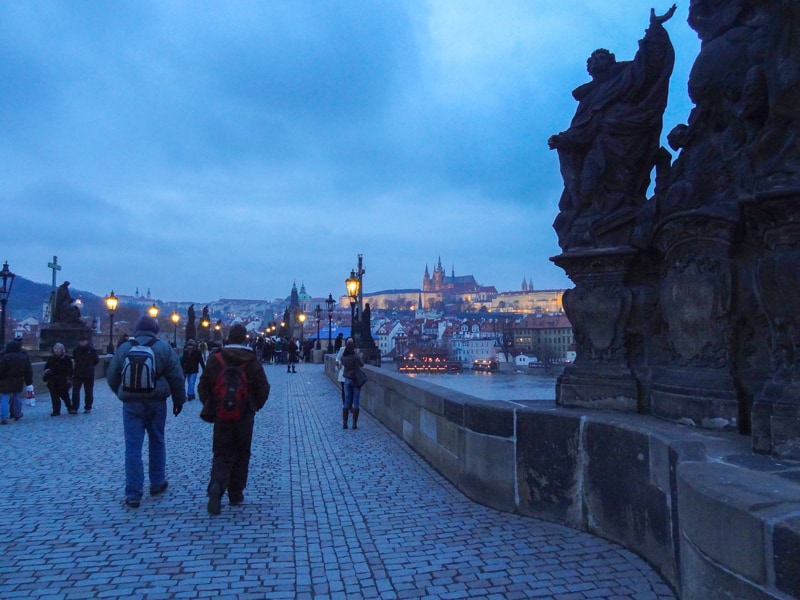
Winter is one of the best times to visit Prague, for a variety of very good reasons…
Estimated reading time: 19 minutes
Updated for 2022
By Jim Ferri
Few cities in Europe are as stunning as Prague. That’s because no other city in Europe can provide you with 600 years of stunning architecture, all untouched by war.
Often called the “City of a Hundred Spires,” the historical center of Prague – the Old Town, the Lesser Town, and the New Town – is a UNESCO World Heritage Site. UNESCO has also described Prague as “one of the most beautiful cities in Europe,” and I couldn’t agree more.
The reason for its beauty is that in the Middle Ages, Prague was at the crossroad of Europe. That also made it exceptionally wealthy.
This wealth helped it evolve into a magnificent, beautiful city larger than London and Paris. But it’s this overabundance of beauty that’s the problem. There are so many remarkable buildings in Prague today that one can easily overlook things that would be a standout in any other city.
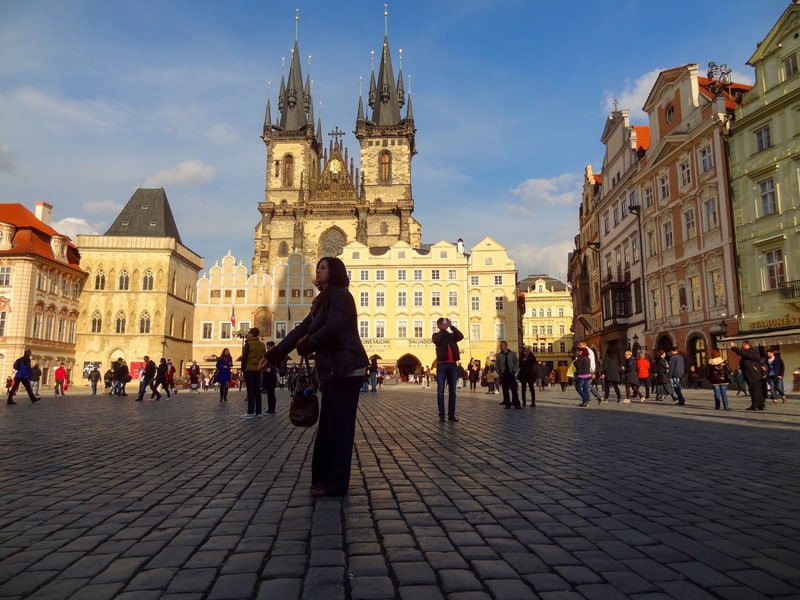
Why Visit Prague In the Winter?
For me, winter is a great time to visit many Eastern European cities. Winter is when most cities come to life.
In the off-season, it’s also easier for me to become unglued in time. I can go somewhere when I’d like to go, rather than sharing the city with thousands of tourists and tour buses clogging the streets. And despite the winter cold in Prague (that really wasn’t that bad), every place we went was very comfortable.
Also, in Prague and some other European cities, prices are much lower in the winter than at other times.
The exception in Prague – there’s always an exception, isn’t there – is during the second half of December. That’s when when crowds arrive to see the city’s famous Christmas markets. The markets, which dazzle you with twinkling lights and a romantic atmosphere, are beautiful, festive events.
The most well-known Christmas market takes place in Old Town Square. As in other European Christmas Markets, there you’ll find a massive Christmas tree and a Christmas village. It’s where you can purchase Christmas decorations, handicraft products, as well as an abundance of mulled wine, Christmas food, etc.
During winter in Prague, there’s also a second period when prices edge up. That’s during Carnival, known as Masopust in Prague, primarily during February. Since the dates change every year, it’s best to check with Czech Tourism for specific dates any year.
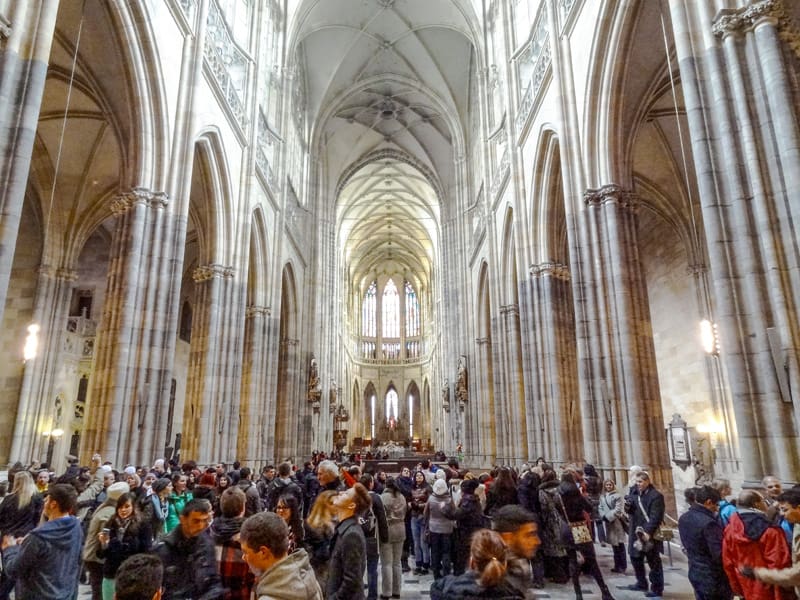
Prague in the Winter, Visiting the Castle and Cathedral
My wife and I didn’t have a lot of time to spend in Prague on our winter visit. Unfortunately, we had only two days, so we needed to make the best use of our time. On our first day, we boarded tram #22 to Prague Castle. When we arrived at the castle we were rewarded with a beautiful view of the city.
Since it was the low season, we found the crowds much smaller in Prague Castle than in the busy warmer months when there are long lines. (Noon is usually the busiest time in every season). Many people come to the castle entrance for the changing of the guard.
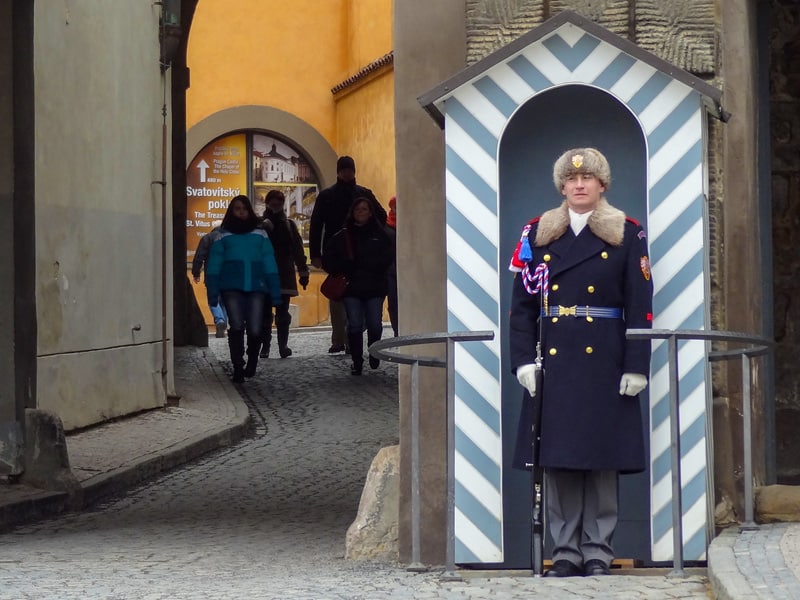
The castle was initially built in the ninth century but was continually added onto over the ensuing centuries. Now, according to Guinness World Records, it’s the largest ancient castle in the world, covering an area larger than seven football fields. It’s also likely the only castle you’ll ever visit where the lighting system was paid for by a rock group. (The Rolling Stones paid for an overhaul of the lighting in four of the castle’s ornate grand halls in 1995).
Inside its walls are the Old Royal Palace (the seat of Bohemian kings since the 11th century), St. George’s Basilica (the city’s most beautiful Romanesque monument), and numerous other buildings, the most famous being St. Vitus’ Cathedral. It houses, among other things, the tomb of Good King Wenceslas.
Before entering the Cathedral, we first went around to its right side to see the “Golden Portal.” It’s the original main entrance and is still open on special occasions. Its named for the beautiful 14th-century Venetian mosaic of “The Last Judgment” above it.
The Real Surprise
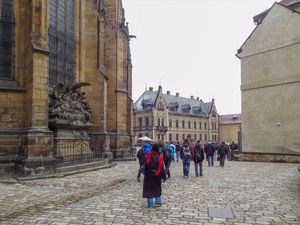
But the real surprise was inside. There we found a treasure trove of magnificent stained glass, unlike any I’d ever seen before, in any church, anywhere. It was the intricacies of the colored glass and the number of panels that flooded the interior with color. It was all stunning.
In addition to the Portal, you’ll also find another “golden” on the castle grounds, Golden Lane. It takes its name from the goldsmiths who lived there in the 17th century, although it was initially built in the 16th century to house the castle guards. Beyond the Cathedral, Golden Lane is a series of colorful small houses, many of which have become souvenir shops. Back in 1916, however, Franz Kafka lived in house number 22.
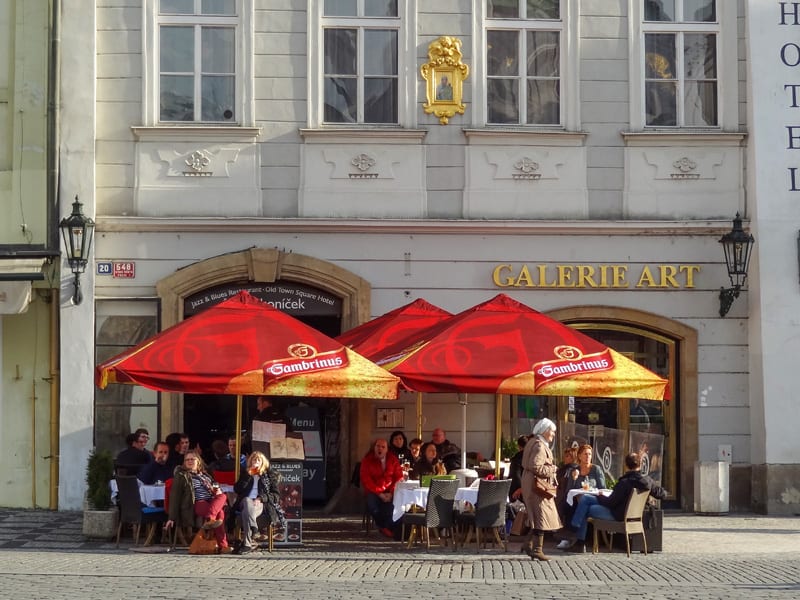
Prague’s Café Culture
Once part of the Austro-Hungarian Empire, Prague retains its ancient café culture. And the city’s cafés can be exceptionally cozy and romantic in the winter.
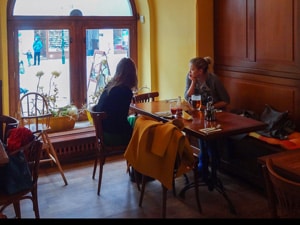
Some of the most famous cafés to enjoy in the city are the Café Louvre (where Albert Einstein and Franz Kafka were patrons), the Art Nouveau Café Imperial, and the Café Savoy, in the Malá Strana neighborhood.
After leaving St. Vitus, we found a little café as we strolled about the castle grounds. It was midway through our walk, and we relaxed there with coffee and a delicious slice of plum cake. We found a plethora of cafes all over Prague during our stay.
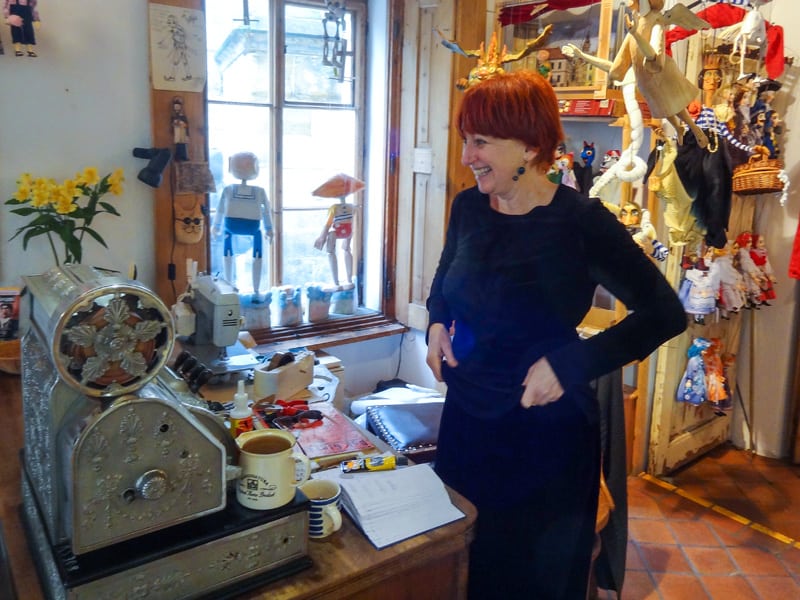
Prague’s Marionette Culture
Following our café interlude, we set out down a narrow walkway to 13th-century Malá Strana, the city’s old quarter that was once home to the craftspeople and merchants who served the royal court. It runs along the river below the castle, and when we reached the river, we headed towards the iconic Charles Bridge, the subject of countless selfies and Prague postcards.
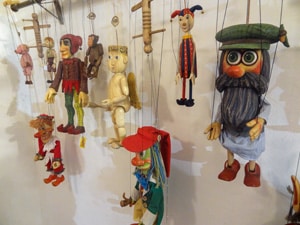
However, to get to the bridge from the riverside, we had to first turn up a street to get to the bridge’s walkway. It is here we stumbled upon Marionety Truhlář, a marionette workshop and studio.
Praguers love marionettes, and the place was overflowing with an incredible number and variety of them – beautiful and whimsical knights, animals, fairies, all sorts of things – that were hanging from the ceiling, walls, and every conceivable spot. They were incredibly well crafted and not cheap, of course, and the saleswoman was enthusiastic about showing us some of the newer ones.
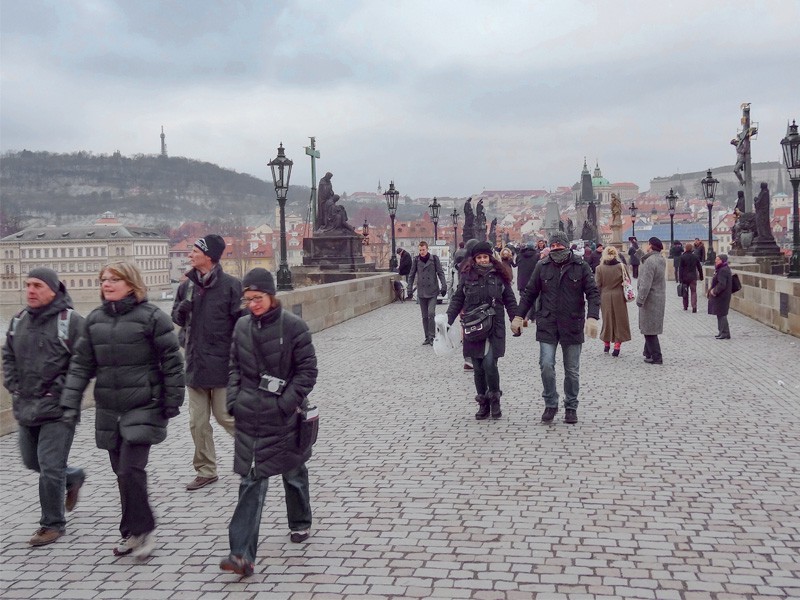
Across the Charles Bridge
Leaving the shop, we crossed the pedestrian-only Charles, a spectacular link between Malá Strana and the Old Town on the far bank, which retains its allure despite being so touristy.
Even though this was Prague in winter, it was still lined with artists, jewelry vendors and the occasional musician at the base of the bridge’s famous black statues all along its length. Every once in a while, we came upon a statue that had a spot rubbed smooth by people wishing for good luck, showing the bright brass beneath.
The statues are interspersed by ornate lampposts, which are still powered by gas although automatically illuminated. Every winter during the Christmas Advent season, however, beginning the fourth Sunday before Christmas, at dusk a lamplighter in period clothing manually lights each of the 46 gas lamps on and around the bridge, a nod to the city’s heritage.
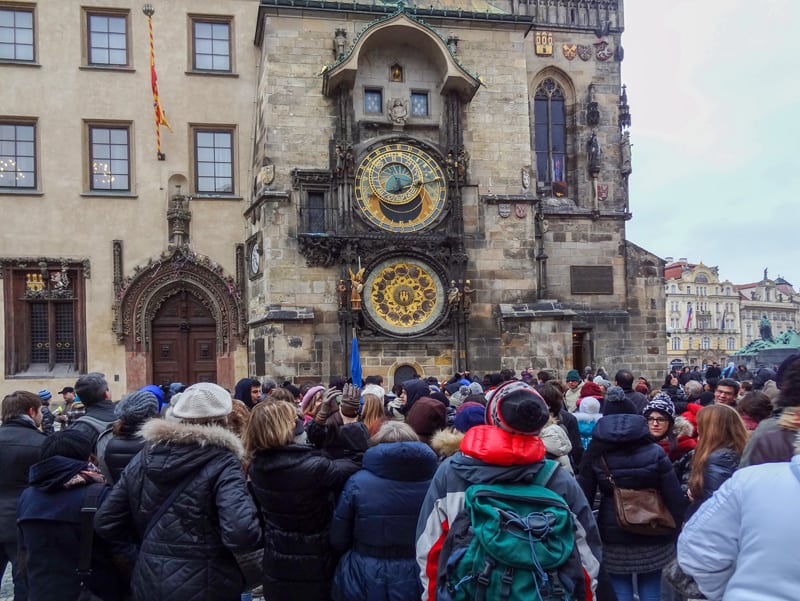
Prague in the Winter – Trdlo Buns in the Old Town Square
It was just a short walk from the Charles to the Old Town Hall with its famous Astronomical Clock. Like many visitors, we spent a lot of time in Old Town Square, which is the city’s true heart.
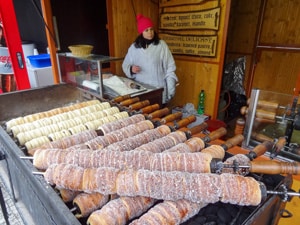
The square is a beautiful place where most tourists eat, drink and mingle in the cafés that pepper the square’s periphery. In the winter, their outdoor areas are kept warm with heaters. It can be pretty comfortable on a day that isn’t too cold. Sitting outside, we enjoyed a snack with wine while watching the procession of the Apostles on the Astronomical Clock.
If you’re hungry and want to forgo the cafes, or just want to sample one of the traditional sugar-and-cinnamon trdlo buns cooked over coals at an outdoor stand, there are several food stands along the Town Hall side of the square that are relatively good.
So grab a bite from one of them and eat while you walk about watching the sideshow of mimes and musicians that come and go all day long.
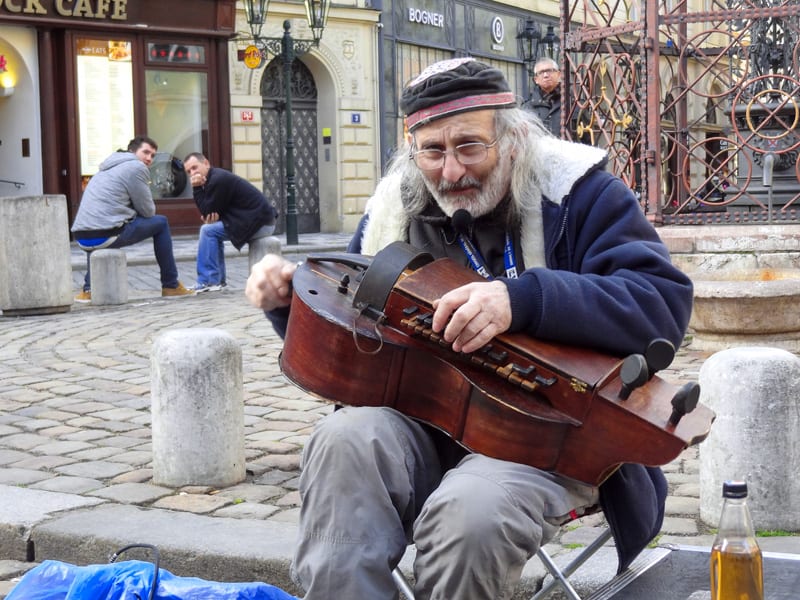
The Old Jewish Ghetto
Behind Town Hall is Josefov, Prague’s old Jewish Ghetto from the 12th century. It’s a great place to wander about.
By the end of the 19th century, many Jews had left, and the area had turned into a slum. It was then that the Ghetto was razed and replaced with a bourgeois district, preserving only a handful of synagogues.
One of them was the 13th-century Staronová synagóga, the Old-New Synagogue, the oldest in Europe. It was initially called the New Synagogue until another was built nearby. After that was destroyed, the original assumed its new name.
Don’t miss walking through the Old Jewish Cemetery. Founded in 1478, for more than 300 years it was the only place where Jews were permitted to be buried. Amazingly, despite its small size, about 100,000 people are buried here, 12 layers deep. The most famous and visited tomb is that of Rabbi Low, a 16th-century scholar.
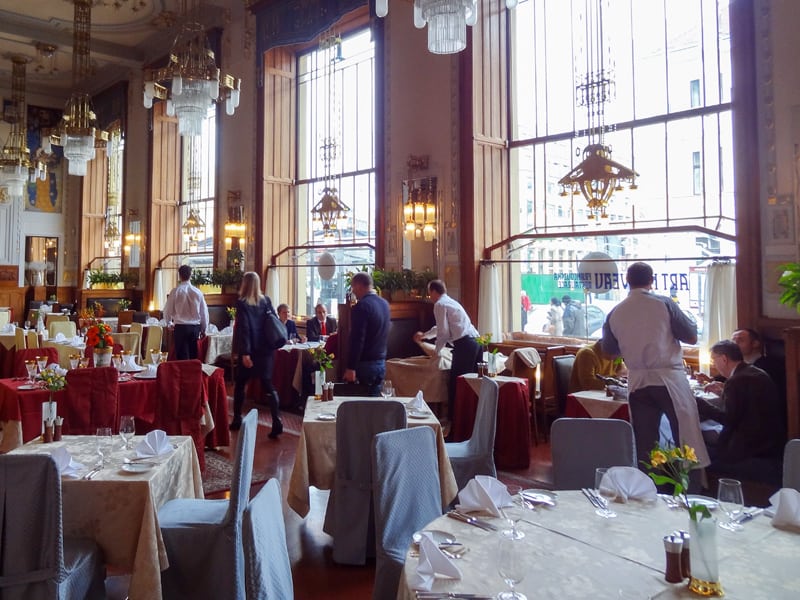
Czech Food and Prague Restaurants
One of the great things about visiting Prague in the winter is that Czech food is hearty, with many popular stews made for the cold weather.
For example, Czech goulash (Gulás) is a hearty beef stew without vegetables, usually served with dumplings, and less spicy than Hungarian goulash. On the other hand, Svíčková na smetaně is a traditional Czech sauce of root vegetables and heavy cream served with pot-roasted slices of beef tenderloin.
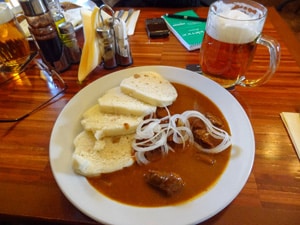
For fast food, try Smažený sýr, also known as “smažák.” It’s semi-hard cheese with breadcrumbs and fried in fat (don’t even think about your cholesterol) and served with a side of French Fries or another type of potato.
All of them, and many other popular Prague foods, are often accompanied by world-famous Czech beers.
You’ll find plenty of good restaurants all over Prague. While in Prague, we stayed at the Jalta Hotel, a boutique hotel that turned out to be quite good both in comfort and service. (One good thing about the Jalta was its location on Wenceslas Square, an easy five-minute walk down the square and through several medieval lanes back to Old Town Square.)
On our first evening there, when we asked at the desk about a good place to eat, he suggested we just go through the door off the side of the lobby.
We did and found ourselves in the Como Restaurant & Café, which we assumed was associated with the hotel but later found out it was privately owned. The last thing we expected to do in Prague was to dine in an Italian restaurant, but it was so good we had dinner there twice.
Below you’ll find the addresses of two other popular restaurants.
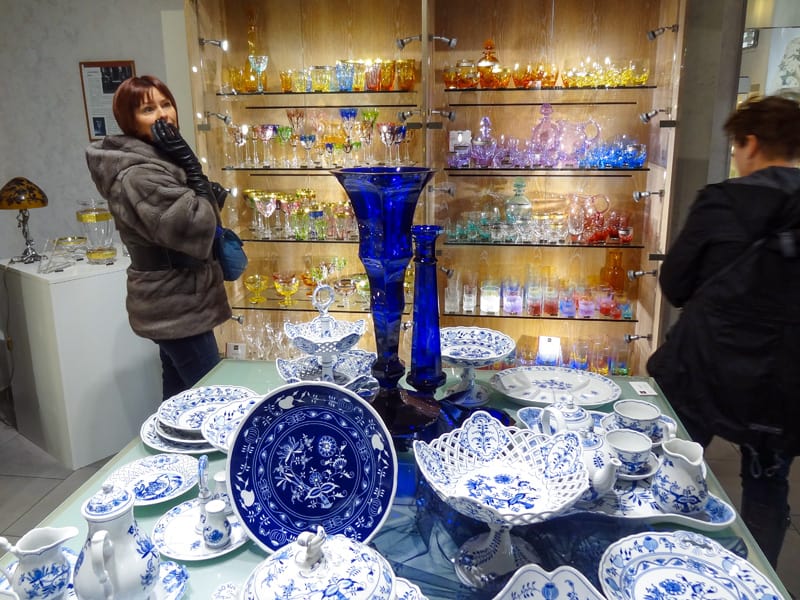
Antiques and a Beautiful Art Nouveau Building
On our second day in the city, we wandered down to the Old Town Square once again, deciding to walk about the old streets behind Tyn Church, whose imposing Gothic steeples are the city’s landmarks. We also wanted to shop in the many small shops in the area.
In the numerous lanes that seemed to run in every direction, we wandered about, dropping into any little shop that attracted us. Finally, in one antique shop we began chatting with the owners, who often have more time to talk with customers during the low season.
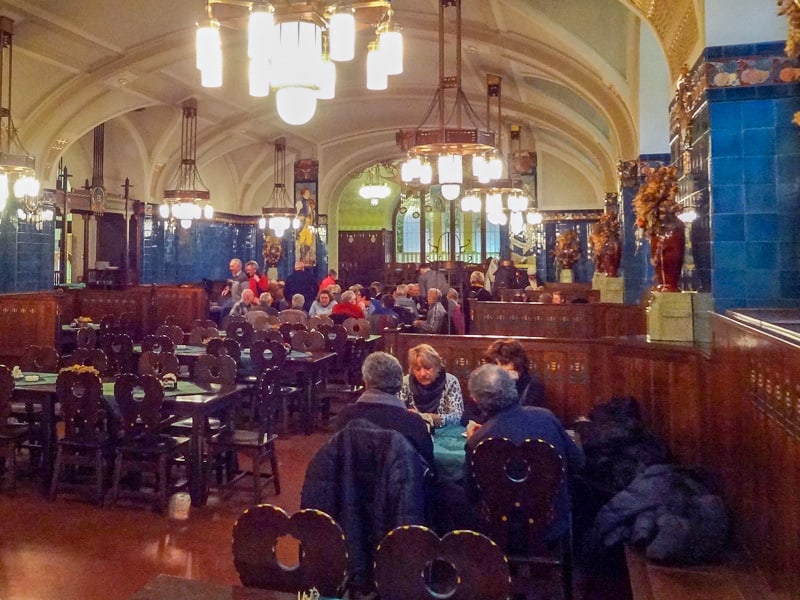
The Municipal House
When I asked for directions to Republic Square, they told us we had to be sure to visit the Municipal House, an old government building there. “It’s a beautiful place,” they both said, leaving us wondering just what it could be. It turned out to be one of the highlights of the city.
Built 1905–1911, Obeccni düm (Municipal House) is a beautiful Art Nouveau building, Prague’s finest. After decades of neglect during the Communist era, it was restored in the 1990s. You’ll find few places like it anywhere in Europe, or the world, for that matter.
In the basement, we found Plzenska, a beautiful Old-World Czech beer-hall-style restaurant with tile walls and stained-glass windows. Next to it was the American Bar, a real old-style American bar where they’ll whip you up a Manhattan, Gin Fizz, or other cocktail of choice. It’s the oldest bar in the Czech Republic and, it claims, the second oldest in Europe.
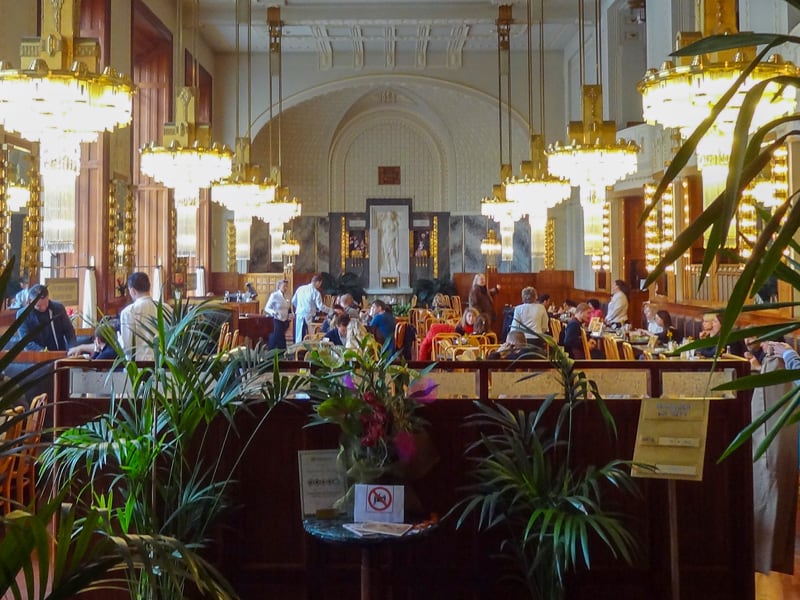
At its heart is the beautiful Smetana Concert Hall, home to the Czech National Symphony Orchestra. But it was its exuberant Art Nouveau restaurants and bar that really caught our attention.
Its real standout is the elegant restaurant Francouzska (now the Municipal House Restaurant), a veritable dining museum of Art Nouveau exuberance, serving French, Czech and international cuisine. It was another good reason to visit Prague in the winter, since you’ll usually have no trouble getting a table there in off-season.
Municipal House was another of Prague’s magnificent buildings, and there were many. And many more we did not see.
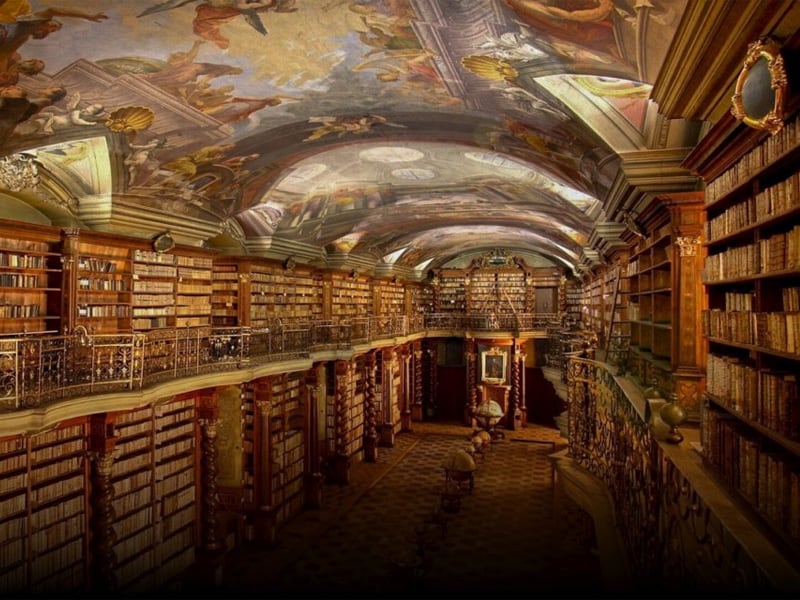
Unique Prague Winter Experiences
Prague’s Vltava River takes center stage in the summer months. Bisecting the city beneath Prague Castle, it flows beneath the Charles Bridge and is the site for many summer events. Many people also enjoy the river, and the views from it, by taking a river cruise in Prague.
However, many don’t realize that you can also enjoy a river cruise during the winter months. Then the passenger area is enclosed and heated. It’s a great way to see the snow-covered city. You might even enjoy a lunch or dinner cruise with spectacular views.
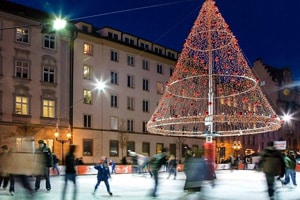
For something unusual, you can also go ice skating in Prague in the winter. Ovocný trh (Fruit Market) in Old Town (not far from Old Town Square) is open for skating every day. It continues into the late evening, although the events are primarily for children.
Under the Zizkov TV tower, the Tower Ice Park is also popular.
If you’re looking for something more culturally oriented in the winter here, you can enjoy concerts at several of Prague’s churches and theaters. There are Christmas concerts in many venues in the winter, primarily in December.
Popular are the classical performances at Prague Castle (in the Basilica of St. George) and at the Klementinum Library (in the Mirror Chapel where Mozart once played the organ). The Klementinum, a historic complex of buildings in Prague that includes the Czech National Library, is always on lists of the world’s most beautiful libraries.
As one would expect, there are also winter concerts in the Smetana Concert Hall of the Municipal House and at Lobkowicz Palace, near Prague Castle and home to the German Embassy. During the entire month of December, you can also enjoy performances of The Nutcracker at the National Theater.
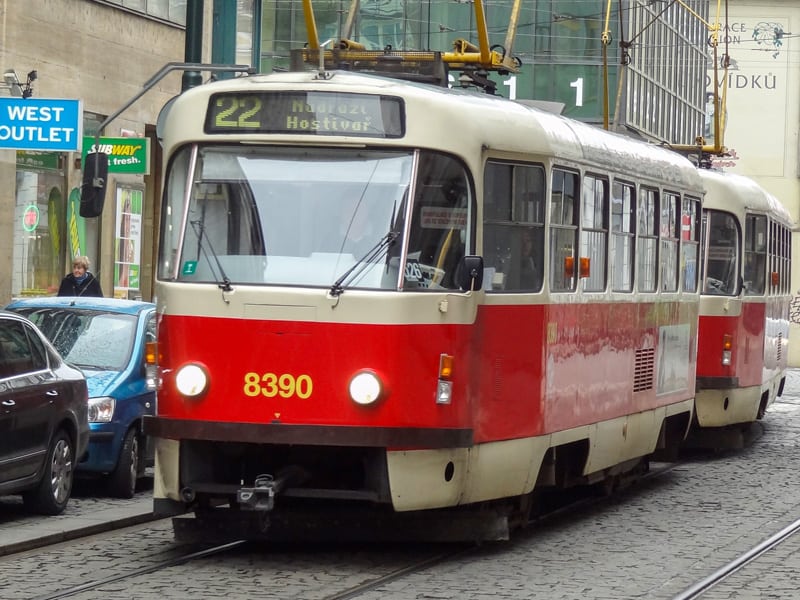
Public Transportation
The city’s Old Town is eminently walkable. If you’re going further afield, you’ll find that there are plenty of taxis, and the city has an excellent public transportation system linked by buses, the Metro, and trams.
There are several types of tickets used on all public transportation in Prague: a 30-minute ticket (30 CZK / Senior 60–65: 15 CZK ); a 90-minute ticket: (40 CZK / Senior 60–65: 20 CZK); a 24-hour ticket: adult: 120 CZK / Senior 60–65: 60 CZK); and a 72-hour ticket: adult: 330 CZK / Senior 60 – 65: 330 CZK). Note: all seniors over 65 years and children under 15 years are free. For free tickets you must be able to provide proof of age to an inspector, if asked.
Both tickets are valid on any type of public transportation and allow transfers between lines (subway to subway, tram to tram, etc.) and transfers between different types of transport (metro to tram, tram to bus, etc.) for up to 30/90 minutes from validation.
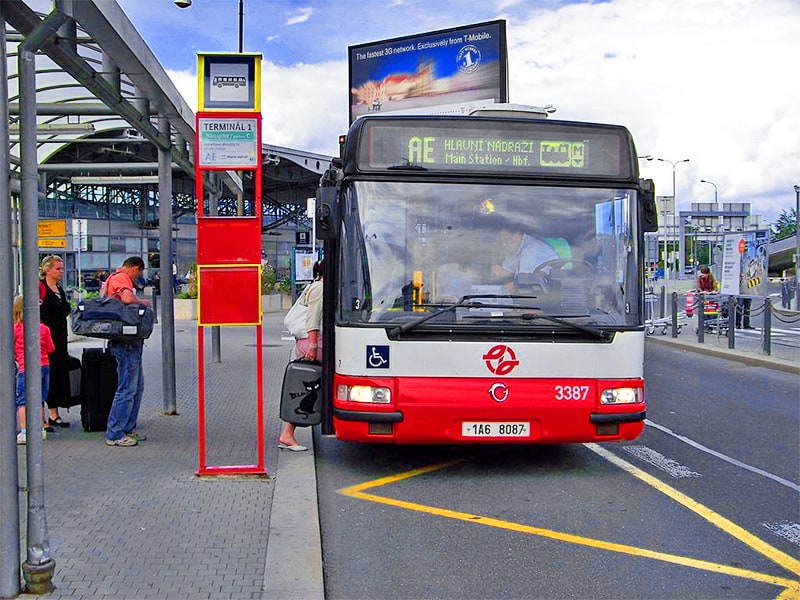
How To Get From Prague Airport to the City
If you’re going to take advantage of all the things to do in the city you’ll first need to know how to get to the city from Prague Airport. Thankfully, it’s relatively easy.
The international arrival airport is Václav Havel Airport Prague. Formerly Prague Ruzyně International Airport, which is why you still see signs with that name, it’s located about seven miles (12 km) outside the city. Taxis to central Prague are CZK 450-500 ($20.50 – 22.75).
An Airport Express bus runs every 30 minutes between the airport and the city’s central train station, which is on line C of the metro. Cost is CZK 60 ($2.73) per adult each way. There is also a local bus making multiple stops for CZK 32 ($1.45). There’s an additional charge on the local bus for pieces of luggage larger than 10 in x 18 in x 28 in. You can buy your ticket at the Visitor’s Center in the airport arrival hall or directly on the bus.
Note that short-term tickets, noted above in Public Transportation, can also be used for traveling from and to the Prague airport on buses 119 and 100 but are not valid on Airport Express buses connecting the airport with the main train station.
You can purchase short-term tickets from the yellow ticket vending machines (also in English), at ticket offices located in many metro stations, at Tabák/Trafika stores, at newsstands, and in tourist information centers.
You may also enjoy: Things to Do in Prague…With a Map for a Walking Tour / Cesky Krumlov from Prague – A Great Off-Season Day Trip / Day-Tours in 5 of the Best Eastern European Cities /
If you go:
CzechTourism
1109 Madison Avenue
New York NY 10028
www.czechtourism.com
@ [email protected]
Tel: (212) 288-0830
Hotel Jalta
Václavské náměstí 45/818
110 00 Praha 1
http://www.hoteljalta.com/
@ [email protected]
Tel: +420 222 822 111
Marionety Truhlář
U lužického sem. 5
Malá Strana, 118 00 Praha 1
http://www.marionety.com
@ [email protected]
Tel: +420 602 689 918

Hi Jim. Really enjoyed this article and those photos are wonderful. I also visited Prague in the off-season. It was wonderful to wander the city without throngs of other visitors. The only minor down-side was the amount of construction and “finishing” work being done to prepare for the main visitor season.
Hi Norm, I’m glad you liked it. To me Prague is a perfect off-season destination (although it’s good during the high season also, if you can just ignore all those other tourists!).
The street musician in your photo, playing the hurdy-gurdy, is Jiří Wehle.